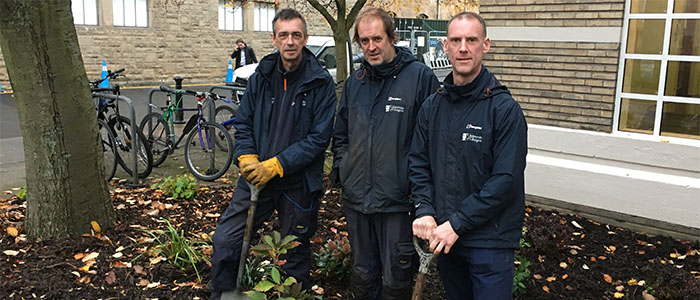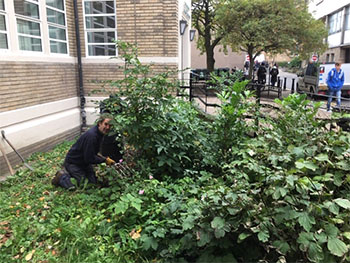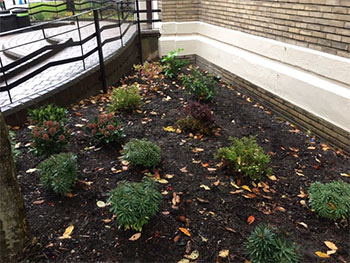Science provides seeds of inspiration
Published: 25 October 2018
Robert Steel, University Gardener, tells how chemistry has inspired the latest leafy addition to the campus.

Robert Steel, University Gardener, tells how chemistry has inspired the latest leafy addition to the campus.
Following the completion of work and removal of scaffolding on the Joseph Black building, the ornamental beds in front of the building were in a bit of a mess.
 It was decided to replant the beds with new plantings, with the brief to match the plants with chemistry. Led by supervisor Jane Marriot, a team of University gardeners including Colin, Ashley and myself set to work to reconstruct the site.
It was decided to replant the beds with new plantings, with the brief to match the plants with chemistry. Led by supervisor Jane Marriot, a team of University gardeners including Colin, Ashley and myself set to work to reconstruct the site.
We had a lot to dig out! The worst of it was the old laurel hedge that was either side of the railings. When the plants were removed we added soil conditioner to improve the soil structure and provide a rich source of organic nutrients into the soil, which is then slowly released improving plant health and humus to the soil.
As well as sourcing plants with a chemistry theme, we had to select plants that were shade tolerant, as the trees and buildings round about provide a considerable amount of shade.
 Once the plants were in it was time to put a variety of bulbs in. Crocus, daffodils and tulips were planted for early flowers in spring time.
Once the plants were in it was time to put a variety of bulbs in. Crocus, daffodils and tulips were planted for early flowers in spring time.
After the planting had been completed we added ornamental bark to finish the beds. The bark suppresses weeds, retains moisture and eventually break down and provide more structure to the soil.
We used a variety of plants that have a special relationship with chemistry, these were:
Hypericum The common name for this plant is St Johns Wort. This plant has been used since antiquity in herbalism and modern medicine today. The two main compounds found in hypericum species are hyperforin and hypercin. Scientific research into the plant has found that when taken as pill or tea infusion has had a noticeable effect in treatment of light to medium clinical depression.
 Both of the main chemicals hyperforin and hypercin have been found to have antibiotic properties and have been used in ointments and oils to help heal wounds.
Both of the main chemicals hyperforin and hypercin have been found to have antibiotic properties and have been used in ointments and oils to help heal wounds.
Potentilla Potentilla has been used in herbal and traditional medicine for thousands of years. Some of the uses have been to calm the gastrointestinal system, reduce inflammation, promote rapid healing, eliminate pain, improve repirotry health and soothe the skin. Research continues on the subject of its efficacy as an alternative medicine.
First published: 25 October 2018

